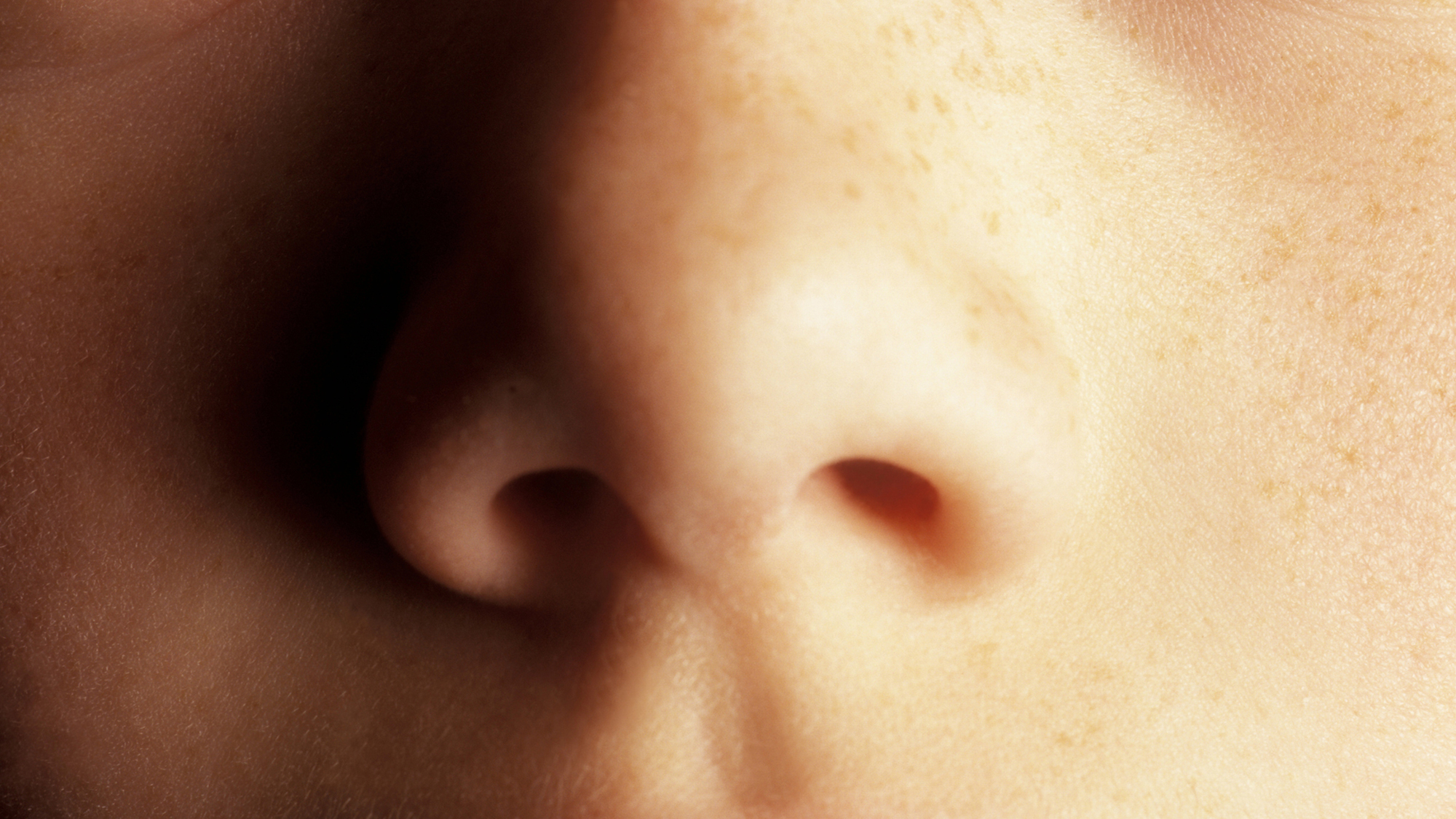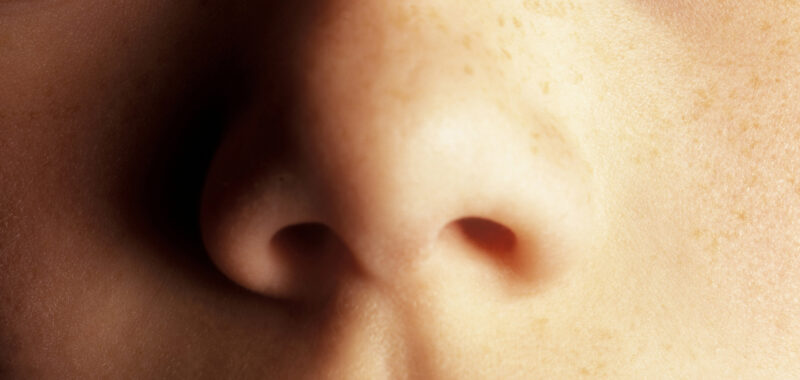
Most peoples’ noses are working overtime. If you have a normal sense of smell, an hour’s worth of breathing comes with hundreds of “exploratory sniffs,” according to new research. These subtle, unconscious inhalation peaks–along with other small signatures–amount to a respiratory pattern that significantly differs from that of people born without a sense of smell.
In other words: Your ability to smell dictates the way you breathe, per the study published October 22 in the journal Nature Communications. Respiratory differences between smellers and non-smellers could have important implications for both physical and mental health, suggest the authors, all scientists within the Olfaction Research Group at the Weizmann Institute of Science in Rehovot.
Smelling “is the most primitive sense,” says Simon Gane, an ENT surgeon at the University College London Hospital who studies olfaction but was uninvolved in the new research. “It’s hooked into a lot of the basic parts of our animal selves,” Gane adds. This study, he says, which demonstrates that core bodily functions like breathing are intertwined with smell, emphasizes how fundamental and important the ability is.
Past work has hinted that odors could impact respiration. In one prior study, scientists observed that exposure to unpleasant smells reduces peoples’ inhalation volume and can distract from a memory task. In another, researchers found that people who can smell modulate inhales in response to potentially irritating stinks. But the new research is unique for analyzing detailed data, collected over a full day and not just a single, brief exposure experiment. “From my knowledge of the literature, this is the first time that this has ever been done, particularly at this level of precision,” says Danielle Reed, Chief Science Office at the Monell Chemical Senses Center, a nonprofit research institution, in Philadelphia.
The sniff test
The study authors fitted participants with wearable devices that tracked air flow in and out of their noses over 24 hours of normal activity. They followed 31 people with self-reported normal olfaction and 21 participants born without a sense of smell (known as “congenital anosmics”). They found that both smellers and non-smellers had similar breathing rates, but that, while awake, smellers’ respiratory patterns included an average of 240 additional inhalation peaks per hour, compared with non-smellers. These “peaks” represent sniffs, or smaller inhalations on top of a smooth breath in, which give each inhale a jagged shape when charted.
During sleep (when past research has indicated people are less attuned to and responsive to odors) the study scientists noted that the number of inhalation peaks evened out between the two groups. Yet other factors, like the variation in the volume of inhalations, significantly differed between smellers’ and non-smellers’–even while they slept. Altogether, these differences were enough for the researchers to determine someone’s smell-status with 83% accuracy, simply by analyzing their breathing pattern.
In one additional experiment, the study scientists tracked the breathing of 32 normal smellers in a controlled, “odor-free” room. In the scentless environment, they found that the smellers’ breathing became much more similar to that of anosmics, suggesting that respiration pattern is an interplay between sensory ability and environment.
Smell and health
Lack of smell can be something you’re born with–as in the rare 1 in 10,000 people with congenital anosmia. Or anosmia can be ‘acquired,’ as when someone loses some or all of their ability to smell as a result of infection, a brain injury, long-term smoking, or another cause (this is much more common than the congenital version, especially among older adults and in the post-Covid world).
Acquired anosmia and other types of olfactory dysfunction are associated with many different health conditions, including depression, diabetes, obesity, cognitive decline, and neurodegenerative diseases like Parkinson’s and Alzheimer’s. One analysis found that people aged 57 and older who lose their ability to smell are three times as likely to die over a five-year period than their peers who retain the ability to detect odors.
The direction of these associations and the mechanism by which smell might be related to something like mortality are poorly understood, say both Reed and Gane. In many cases, researchers suspect that the sense of smell is a figurative canary in the coal mine, indicating the onset of some broader decline or disease, as opposed to the trigger for the decline itself, explains Reed.
Yet lots of people who lose their sense of smell do report a significant decline in the quality of their life, attributed specific to their newfound anosmia–citing things like dietary changes, depression and dulled emotions, and social isolation. Breathing is obviously critical for survival, as our bodies need oxygen coming in and carbon dioxide moving out. Subtle shifts in how one breathes are well-known to affect things like heart rate and even mood and stress level. Therefore, the study authors suggest that olfaction-related differences in respiration could be related to the known, negative health impacts of smell loss. “Shifted respiratory patterns, and particularly nasal airflow patterns, may have an impact on physiological and mental health,” they write.
There’s a catch
However, a major limitation of the study is that it only compares congenital anosmics with normal smellers, and not those with acquired anosmia, says Rachel Herz, a neuroscientist and adjunct professor at Brown University who wrote the book, The Scent of Desire: Discovering or Enigmatic Sense of Smell. A lifelong inability to smell, in contrast with losing one’s ability to smell, is not associated with the same spate or problems, she explains. “There is no literature suggesting that people with congenital anosmia are at higher risk” for the health-related perils that those with acquired anosmia face, Herz says.
Gane agrees with that critique. That respiration changes could contribute to the health issues associated with acquired anosmia is “an interesting conjecture, but the study doesn’t support it directly at all,” he says. In fact, by focusing on a generally healthy group of congenital anosmics, and still identifying a distinct breathing pattern, he notes that the study authors seem to be undermining their own idea.
To better determine if the breathing pattern identified in the study has any potential health effects, every source Popular Science spoke with said they’d like to see the observations repeated in people with acquired anosmia. Additionally, tracking physiological markers like blood-oxygen level along with respiration could help suss out implications, says Johannes Frasnelli, an associate professor of chemosensory neuroanatomy at the University of Quebec à Trois-Rivières. If the suggested links are supported by further research, breathing exercises may turn out to be a “low risk, high reward” way to mitigate the health impacts of smell loss, says Reed–but that’s a big maybe. “This is the beginning of what I think will be a lot of [follow-up] work,” she adds.
Still, even on its own, the study offers “a fascinating and puzzling finding,” in an oft-overlooked field, says Frasnelli. It may seem basic that sniffing and breathing would be linked, but smell is so understudied in comparison to other senses, that it’s taken us until now to realize the scientific extent. “It goes to show,” says Gane, “that we need to take olfaction a bit more seriously.”

